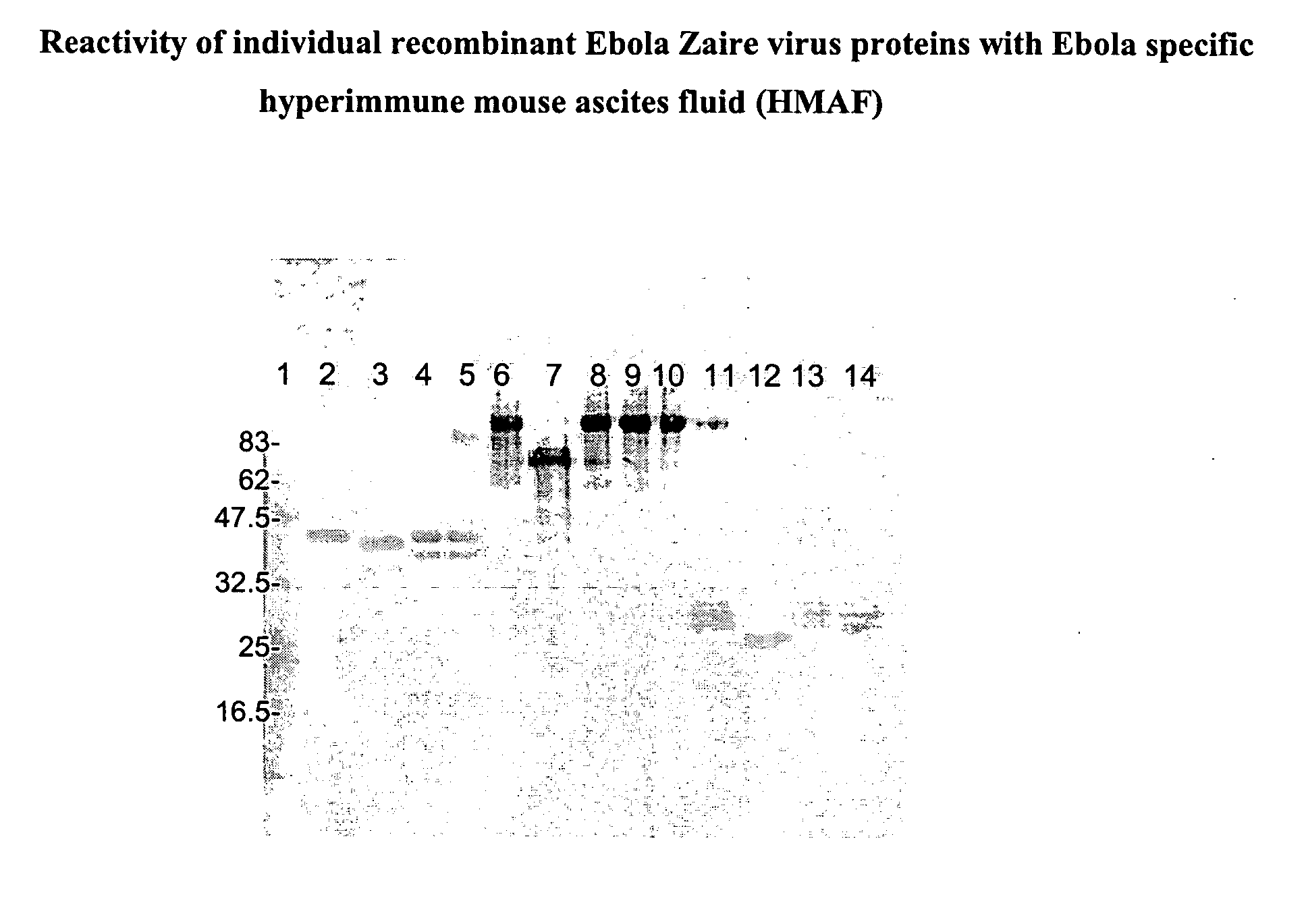Recombinant proteins from filoviruses and their use
- Summary
- Abstract
- Description
- Claims
- Application Information
AI Technical Summary
Benefits of technology
Problems solved by technology
Method used
Image
Examples
example 1
Cloning of Filovirus Structural Genes and Expression in Insect Cells
Cloning of Required Genes into Vectors for Expression in Insect Cells
[0107] Sequences for expression of four selected Ebola Zaire virus proteins nucleoprotein NP, glycoprotein GP and the small viral proteins VP24 and VP40 were accessed from Genbank (www.ncbi.nlm.nih.gov / Genbank / index.html) Ebola Zaire, Mayinga strain; accession number NC—002549. PCR amplification used specially designed DNA primers and cDNA plasmids to prepare the properly positioned inserts containing required restriction sites and stop codons. This allowed directional cloning into the selected expression vectors (pMT / BiP / V5-His A (with BiP secretion signal) and pMTN5-His A (no secretion signal), Invitrogen Corp., www.invitrogen.com). All plasmids contained the Drosophila metallothionein promoter to allow inducible protein expression in insect cells.
[0108] The endogenous secretion signal (first 32 amino acids) of the surface glycoprotein GP gen...
example 2
Purification of Recombinant Filovirus Proteins
[0116] Monoclonal antibodies specific to individual Ebola virus proteins obtained from United States Army Medical Research Institute for Infectious Diseases (“USAMRIID”) (Table 3) were coupled to NHS-sepharose (Amersham; www.amershambiosciences.com) at ratios of 10 mg to 1 ml of matrix. Culture medium was loaded directly onto the immunoaffinity chromatography (IAC) columns and bound protein was eluted with 20 mM glycine buffer at pH 2.5 after a PBS wash. Eluates were neutralized and buffer exchanged into PBS using ultrafiltration devices (Centriplus, Millipore; www.millipore.com). Final products were filtered using 0.2 μm syringe filters and protein content determined by UV absorption and gel-electrophoresis. Silver staining of final gels was used to determine the approximate purity of proteins (FIGS. 3, 4 and 5). Yields and purity of each protein are summarized in Table 4.
TABLE 4Summary of purified soluble Ebola proteinsSoluble Ebola...
example 3
Immunogenicity of Recombinant Ebola Virus Proteins in Balb / c Mice
[0128] The immunogenicity of the purified recombinant VP24, VP40, and GP95 proteins was tested in Balb / c mice. The candidate vaccines were formulated using two adjuvants with different modes of action. The saponin-based GPI-0100 (Hawaii Biotech, Inc.) provides a direct immuno-stimulatory and -modulatory effect, while Montanide ISA-51 (Seppic, www.seppic.com) is an oil-in-water emulsion that provides a depot effect. Mice were immunized by subcutaneous injection three times at 4-week intervals with the test vaccine formulations. Details of the experimental groups are summarized in Table 5 below. One week after the third dose, 5 mice from each group were splenectomized. The rest were terminally bled two weeks after the third dose. All mice were also tail-bled at weeks 2 and 6. Splenocytes were stimulated in vitro with antigen and analyzed for proliferative capacity and secretion of cytokines post-stimulation (by ELISA). ...
PUM
| Property | Measurement | Unit |
|---|---|---|
| Fraction | aaaaa | aaaaa |
| Fraction | aaaaa | aaaaa |
| Fraction | aaaaa | aaaaa |
Abstract
Description
Claims
Application Information
 Login to View More
Login to View More - R&D
- Intellectual Property
- Life Sciences
- Materials
- Tech Scout
- Unparalleled Data Quality
- Higher Quality Content
- 60% Fewer Hallucinations
Browse by: Latest US Patents, China's latest patents, Technical Efficacy Thesaurus, Application Domain, Technology Topic, Popular Technical Reports.
© 2025 PatSnap. All rights reserved.Legal|Privacy policy|Modern Slavery Act Transparency Statement|Sitemap|About US| Contact US: help@patsnap.com



